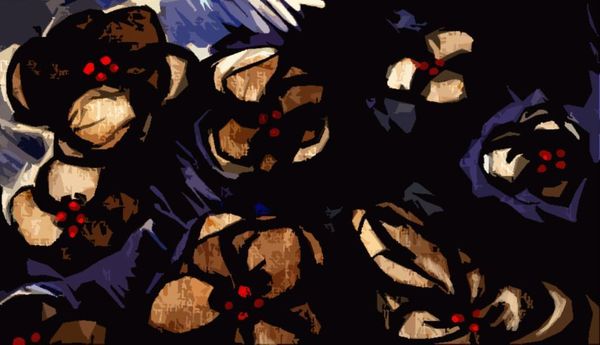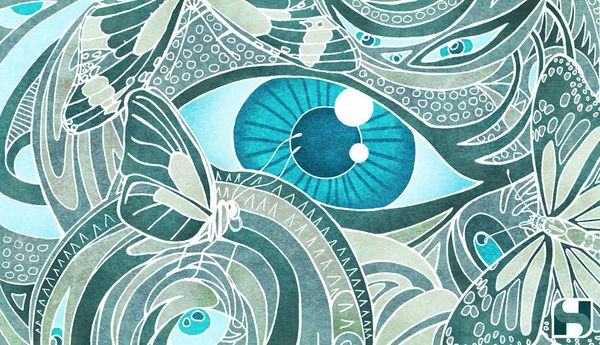The Eye Sees More
Rage burned like homicide inside me. Those drivers had death coming to them. They were part of the surveillance machine. I pantomimed with my four-pronged cane, and pretended it was a high-powered rifle, like a sniper’s rifle in WWII Stalingrad. A medalled sharpshooter who lived to tell war stories. Since I took anti-psychotic and anti-depressant medication, I couldn’t buy a weapon.
It would be more daunting than shooting Nazis from bombed out buildings. It required perfect timing since I, who preferred a wombed life, might send a bullet through my window as well as the opposite tenant’s front window, then the shell(s) would smash through that domicile’s sliding door’s glass adjacent to the parking lot, assassinating a driver or two. A spider’s leg-width miscue and I’d put a sniper’s bullet into the head of the neighbor reading, seated at his kitchen table. With closed blinds, rifles with night-vision sights would be useless at nightfall.
When impossibility became necessity, I would act. I phoned the American Civilian Rights Union and asked about getting a court order to stop the harassment. The attorney told me she couldn’t believe that happened, then asked me whether I see a psychiatrist. I answered yes. The attorney said goodbye and hung up. That was why I wrote emails to my psychiatrist. I will document this left-turn virus.
I saw K Street from my position. A real mensch might liquidate a driver if he saw half the vehicles from vehicles on K Street left-turn into the parking lot. It had persisted too long, this disruption.
Crippled, though I sat in a rocker rather than wheelchair, I looked out the window. I watched vehicles turn left into the parking lot. The businesses hadn’t that many customers but still drivers turned on their left blinker light and passed my line of sight. I saw them through my triplex apartment’s large window into another large window with opened blinds in an identical unit as mine. Then to the rear with the sliding door’s drapes opened. Through three panes of glass, I had a clear view of the lot, seeing all makes and models of cars and trucks pass the backsides of a real estate office, sushi bar, bottled water store, Chinese restaurant, and blocked from sight, a fast food eatery.
It got so distracting I stopped reading. I held Jim Thompson’s The Criminal on my lap, its cover of a man’s face half darkened. No ambition to open it, I saw the parade of vehicles, if only a fraction of each car or SUV or truck. My agitation waned, touching the face, rubbing my fingers over the title, a poor but sensible substitute for imagining the impossible.
Feeling the cover subdued me and though I sat staring at different colors of vehicles, I pretended they all were part of a single abstract expressionist work. I felt castrated, my manhood cut down. Testicles: The seeds of ferocity. I rubbed the cover of The Criminal, an anti-talismanic object, wishing misfortune. I invoked only traffic accidents, the gorier the better.
I abided by a Douglas Coupland sentence: “Our achievements may make us interesting, Tyler, but our darkness makes us lovable.” That’s why I thought of my gonads getting sliced off: I wanted love, the kind that brings justice to the world. That man standing in front of a tank in Tiananmen Square, daring the tank to crush him, succeeded in heroism. Maybe I could do that, screwing myself out of this rocker, walk around the row of triplexes, and stand with my cane, stopping a tow truck (I’d seen one left-turn before). I might stem the flow after a hard-earned warning: Stop pestering me. I might be acclaimed, YouTube capturing my fearless, bold maneuver. But the weight of medication kept exquisite savagery in check.
I placed the headphones back on, listening to death metal on Spotify. Like a ceasefire during armed conflict, I had to accept its terms. Stuck in a great dismal swamp, I stopped massaging the cover, put down my cane-rifle, and scanned the autocade.
Suddenly (everything imaginable was always sudden), a car jumped the curb and passed outside the well-maintained lawn. I saw drivers clearly now. One had a walrus mustache, longish silver hair, a smartphone in his left hand, stopping momentarily for greater impact. Then the car hooked a right and drove past the row of triplexes. I saw the neon green Chevy turn right rather than left across the parking lot, then out of sight. He turned right to reach one-way K Street.
Others followed, rubbing their fenders against the side of my apartment. I heard paint scraped off, a woman talking into a headpiece attached over her head, then she listened for instructions. Surprisingly, after a legion of vehicles did likewise, no damage was done to the shiny, just-mown grass. No tire marks, no muddied yard.
I don’t believe in miracles, only in what I saw. “The Eye sees more than the Heart knows,” wrote William Blake.
A driver blew an air horn, gave me the finger, and told me, “Dan’s shit.” I raised my cane, jammed it against my windowpane, and cracked the glass. At bedtime I felt the autocade rumble my mattress, and heard the roar of engines. I got up, switched on the light and saw full-size vehicles in the bedroom doing what they do best: terrorize me at night. Not diminutive ones, but vehicles of normal size, from an itsy-bitsy battery-driven car to compacts to eighteen-wheelers. I snapped photos of them with an old Polaroid camera. Hard copy needed for proof that I hadn’t hallucinated. Then they drove around my large walk-in closet, their exhaust dirtying my clothes. Carbon monoxide could’ve executed me, but I survived.
In the morning, heating oatmeal in the microwave, spreading dark red miso on toast, I saw them pass through the kitchen wall. A Star Trek transporter beam dematerializing and rematerializing? I had had three strong cups of black tea so I’d rid myself of a medication hangover. I ate steel cut oats in unsweetened Almond Milk (no fat, cholesterol, or sugar) and saw manufactured-sized vehicles in the bowl. I sighted the oatmeal, accompanied by another sense, taste, and more left-turners drove across the hot cereal.
I spread organic miso, hummus, and vegetarian refried beans on whole-grain toast: More cars and trucks, life-sized, traveled across the right side of toast then made a hard left-turn on the topping, confronting me with another conveyance. Tread marks appeared on the triple dip; these autos, buses, vans and trucks no models I glued together as a child’s hobby. Washing the bowl, I saw a vehicle with amphibious ATV tires splash through sudsy water. Organics hadn’t protected me from the left-turner’s toxic existence.
Afterward, I sat down and drank black tea, and listened to Bela Bartok on Spotify, his concerto for orchestra. The caravan continued, insinuating itself within each bar of music.
The violators sprung into view as I listened to piano, horns, and violins, their tonality and non-harmonic modes. Synesthesia gave sight to my hearing and I saw vehicles nudge into chords of Bartok’s masterpiece. The strings’ powerful tension created more vehicular traffic, all European-made vehicles; this masqueraded as humor from the opposition.
An English painter, John Martin, his The End of the World or The Great Day of His Wrath, tacked to my wall: a thirteen by nineteen inch poster, a precise, and detailed depiction of tumult roiled in thick, smoky eruptions crashing down on earth’s inhabitants. Vehicles, not drawn to scale but full-bodied, drove through the furious end-time. I lay among the dead in the reproduction. A driver’s hit and run maneuver failed.
I walked back to the rocker and saw more left-turners, and for once saw someone I recognized behind the wheel: A shriveled, long white-haired, death-faced man, the other drivers much younger than he. Hairy warts sprouted from his face, a pulsating purple vein at his forehead, slivery hands on the wheel. He drove slower, turned his head, and let me see myself with an additional fifty years or so. I’m forty-one.
The deal with the psychiatrist was I couldn’t e-mail him about my mental condition. I could send only fiction to his email address. Violent and paranoid chatter were okay during appointments, but not in emails.
He would now know the Eye sees more than the Heart, because the Blakean Heart stood for reason, analysis, and intellect, worthless in the bare teeth of reality.




